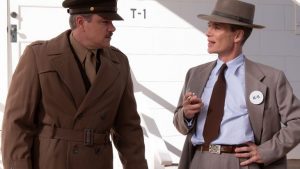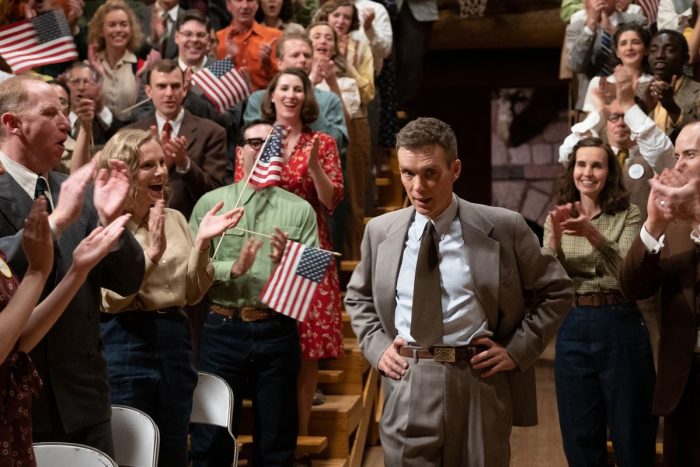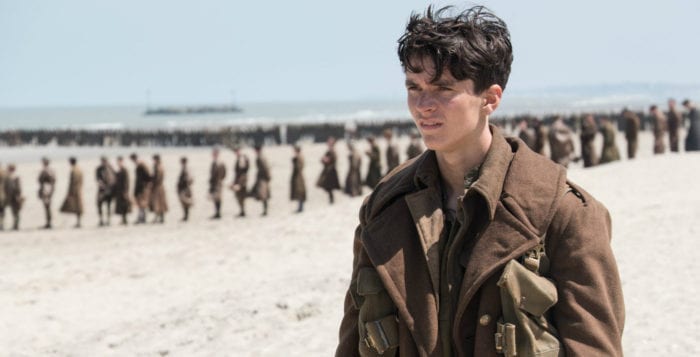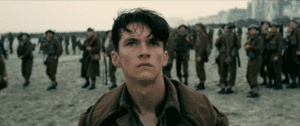Reviewed by Jeffrey Sanzel
J. Robert Oppenheimer (1904-1967) is considered a founding father of the American school of theoretical physics. His work included the exploration of astrophysics, nuclear physics, spectroscopy, and quantum field theory. In the 1930s, he wrote papers suggesting the existence of what are now labeled black holes.
At the dawn of World War II, Oppenheimer was instrumental in developing the atomic bomb (often referred to as its “father”). In June 1942, he was appointed scientific director of the Manhattan Project and supervised the construction of the Los Alamos laboratories.
Following the War, Oppenheimer assumed the chairmanship of the General Advisory Committee to the Atomic Energy Commission (AEC). In this role, he voiced opposition to the development of the hydrogen bomb. In 1953, at the height of the Cold War and Red Scare, Oppenheimer was accused of communist sympathies, and the AEC canceled his security clearance.

In the year’s best film so far, director Christopher Nolan’s epic Oppenheimer traces the controversial figure’s rise, fall, and redemption. Nolan’s screenplay, closely adapted from Kai Bird and Martin J. Sherwin’s 2005 Pulitzer Prize-winning biography American Prometheus: The Triumph and Tragedy of J. Robert Oppenheimer, runs on three timelines: the buildup of the Manhattan Project, leading to the dropping of the atomic bomb on Hiroshima and Nagasaki; the AEC’s rigged hearing that stripped Oppenheimer of both prestige and access; and Lewis Strauss’s senate confirmation hearing for Secretary of Commerce.
Many films tackle issues of scientists and scientific discovery: The Imitation Game (2014), A Beautiful Mind (2001), Hidden Figures (2016), and The Theory of Everything (2014) are examples of some of the stronger genre offerings. However, these films often stress the personal elements or water down the science. In the case of Oppenheimer, the epic but breathtakingly paced three hours manages to keep science in the forefront without losing interpersonal relationships.
The film begins with twenty-two-year-old Oppenheimer struggling with anxiety at Cambridge’s Cavendish Laboratory. After an aborted attempt to poison his professor, Oppenheimer meets Niels Bohr, who suggests he complete his education in Germany. Upon graduation, Oppenheimer begins teaching at the University of California, Berkley, and the California Institute of Technology. The film balances his day-to-day life, including his left-leaning politics, with an attempt to show his genius through strong, abstract imagery.
Much of Oppenheimer plays in lectures and classrooms, as well as offices and laboratories. Nolan keeps the action moving and the stakes perpetually high. The rise of Hitler deeply affects the scientific community, many of whose members were Jewish. In 1942, General Leslie Groves recruits Oppenheimer to lead the Manhattan Project. Oppenheimer gathers an extraordinary team to secretly develop the atomic bomb in Los Alamos, New Mexico. Throughout, the scientists debate the issues of the long-term and far-reaching effects of their actions. In addition, the constant specter of espionage hovers over the project.
The film builds to the first of several milestones with the Trinity, the test of the atomic bomb on July 16, 1945. Simultaneously, it highlights the perpetually shifting collaborations, suspicions, setbacks, and infighting throughout the three years of development.
Marking his sixth collaboration with Nolan, Cillian Murphy delivers a flawless performance as the gifted, complex Oppenheimer. He brings a range of shades, from the self-important to the self-doubting. Following the dropping of the atom bomb, his simple, devastated, “And now I am the condemned. Destroyer of worlds,” is of Hamlet proportions. He manifests the struggle between the intense scientist and the man drawn to the power given to him as leader of the Manhattan Project. A womanizer who loves his wife, a father who shows little interest in his family, and a man later plagued by his choices, Murphy delivers a truly Oscar-worthy performance.
Equal to Murphy is Robert Downey, Jr., as the seemingly mild, almost benign, but ultimately vindictive Lewis Strauss, who offered Oppenheimer the directorship of Princeton’s Institute for Advanced Study. Downey, Jr. gives one of his finest, most dimensional performances as Strauss’s real and imagined slights drive him to take down the scientist. As with Murphy, Downey, Jr., will most likely receive an Academy Award nomination (if not a win).
Emily Blunt makes alcoholic and volatile wife, Katherine, a frustrating and noble figure. Matt Damon’s General Groves is the company man who sees the bigger picture. Florence Pugh’s independent communist Jean Tatlock brings both sensual and tragic qualities to Oppenheimer’s sometimes lover. David Krumholtz is powerfully understated as Isidor Rabi, a voice of wisdom and conscience, as is Tom Conti as the knowing Albert Einstein.
In the Senate confirmation hearing, Rami Malek’s David Hill smartly projects shades of Joseph Welch taking down Joseph McCarthy. Kenneth Branagh makes a strong cameo as Niels Bohr, and Gary Oldman, one of the greatest actors of his generation, is indelible as President Truman. Josh Hartnett, Casey Affleck, Jason Clarke, Matthew Modine, and Tony Goldwyn are among the dozens of supporting performers who comprise this exceptional ensemble.
Hoyte van Hoytema’s astonishing cinematography enhances and highlights the shift in time and place, perfectly complementing the work of production designer Ruth De Jong. Every element is in perfect synchronicity, from costumes to soundtrack. But Nolan, as Oppenheimer’s creator, manifested this exceptional undertaking. He skillfully blended science, politics, and morality into a cinematic gem that will be honored now and remembered as a work as complicated and brilliant as its subject.
Rated R, the film is now playing in local theaters.







